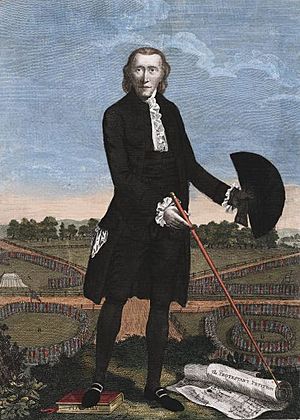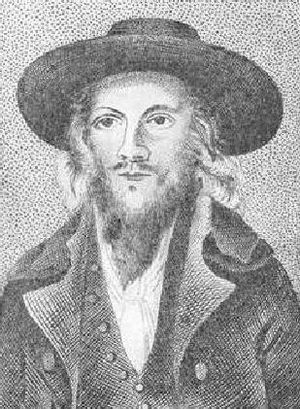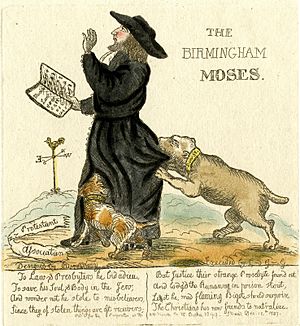Lord George Gordon facts for kids
Lord George Gordon (born December 26, 1751 – died November 1, 1793) was a British politician. He is most famous for the Gordon Riots that happened in London in 1780.
He was born into a noble Scottish family and served in the House of Commons (part of the British Parliament) from 1774 to 1780. Later in his life, he faced some difficulties, especially after he converted to Judaism, which made many people turn away from him. He passed away in Newgate Prison.
Contents
George Gordon was born in London, England. He was the youngest son of the 3rd Duke of Gordon. When he was just 8 years old, in 1759, he joined the army. Later, at age 12, he went to Eton College for his education, and then joined the Royal Navy in 1763.
He became a lieutenant, but his career in the navy didn't go further. He often spoke up about the poor living conditions of sailors, which made him popular with them but not with his officers. He left the navy in 1777. He was against the American War of Independence and did not fight in it.
Time in Parliament
In 1774, George Gordon became a Member of Parliament for a place called Ludgershall. He was chosen without anyone running against him. He was known for being a bit unpredictable and wasn't seen as a very important politician at first.
From the moment he joined Parliament, he strongly criticized the government's policies towards the American colonies. He supported American independence and often spoke in favor of the colonies. He sometimes even criticized other important politicians, which made it hard for him to gain many followers.
The Gordon Riots
In 1779, Lord George Gordon started a group called the Protestant Association. This group wanted to cancel a law from 1778 that had given some rights back to Roman Catholics in Britain.
On June 2, 1780, he led a huge crowd of about 50,000 people. They marched from St George's Fields, south of London, to the Houses of Parliament. They wanted to give a large petition (a formal request) against the new law that helped Catholics.
After the crowd reached Parliament, the "Gordon Riots" began. At first, the crowd left, but they soon came back. Over several days, they destroyed Catholic churches and homes. They also set fire to Newgate Prison and broke into other prisons, letting prisoners out. They even attacked the Bank of England. The army was eventually called in to stop the unrest. About 450 people were killed or hurt before order was restored.
Because of his role in starting the riots, Lord George was accused of high treason (a very serious crime against the country). He was held in the Tower of London. He was later found not guilty, thanks to a strong defense from his cousin. The court decided he didn't intend to betray the country.
Life in Prison
In 1786, the Archbishop of Canterbury removed him from the Church of England because he refused to testify in a church court case. In 1787, he was found guilty of saying untrue and harmful things about Marie Antoinette (the Queen of France) and the French ambassador. He was also accused of criticizing the justice system in England.
He managed to escape to the Netherlands, but he was asked to leave that country. He returned to England and was caught in Birmingham. In January 1788, he was sentenced to five years in Newgate Prison with some strict rules.
Becoming Jewish
In 1787, when he was 36 years old, Lord George Gordon converted to Judaism. This happened in Birmingham, though some say it happened earlier when he was in Holland. He had a special Jewish ceremony called brit milah (ritual circumcision). He took on a new Jewish name: Yisrael bar Avraham Gordon, which means "Israel son of Abraham." In Judaism, a convert is seen as a spiritual child of the Biblical Abraham. This made him a "Ger Tsedek" or a righteous convert.
Not much is known about his life as a Jew in Birmingham. However, a newspaper reported in 1787 that he had been living among Jewish people since 1786. It said he had a very long beard and wore Jewish clothes. He was also very careful to follow Jewish food rules, called kashrut.
While in prison, Gordon lived as an Orthodox Jew. He wore his tzitzit (fringed garment) and tefillin (prayer boxes) every day. He fasted on Jewish fast days and celebrated all the Jewish holidays. The prison gave him special kosher meat and wine, and Shabbat challos (bread) for the Sabbath. He was even allowed to have a minyan (a group of ten Jewish adults for prayer) on the Jewish Sabbath. He also put a mezuza (a small scroll with prayers) on his cell door, and the Ten Commandments were hung on his wall.
Gordon only spent time with very religious Jews. He was so excited about his new faith that he didn't want to deal with any Jew who didn't follow the Torah's (Jewish law) rules. Many non-Jews wanted to visit him in prison, and he welcomed them. But he asked the guards to only let Jewish visitors in if they had beards and wore head coverings.
He often went to other parts of the prison to comfort other prisoners. He would talk with them and play the violin. Following Jewish laws of charity, called tzedaka, he gave what little money he had to those who needed it.
The famous writer Charles Dickens wrote about Lord George Gordon in his novel Barnaby Rudge. Dickens described Gordon as a truly good and pious man, a tzadik, among the prisoners. He wrote that prisoners missed him because even though he didn't have much money, he was very charitable. He helped everyone, no matter their religion.
On January 28, 1793, Lord George Gordon's prison sentence ended. He had to appear in court to promise good behavior for the future. In court, he was told to take off his hat, which he was wearing as a kippah (head covering). He refused, saying he wanted to show respect to God by keeping his head covered. The hat was taken from him, but he covered his head with a nightcap and a handkerchief. He told the court he had been in prison for five years with criminals and that his only comfort came from trusting God.
His brothers and sister offered to pay for his bail (money to be released from prison). But Gordon refused their help. He said that asking for a pardon would mean admitting he was guilty, which he didn't believe he was.
Death
In October 1793, Lord George Gordon caught typhoid fever. This illness was common in Newgate Prison that year. Many prisoners and friends waited outside his cell, praying for him to get better, even though they risked getting sick themselves. But George "Yisrael bar Avraham" Gordon passed away on November 1, 1793, at the age of 41.
He was not buried in a Jewish cemetery. This was likely because people feared his grave might be disrespected. Instead, he was buried in a separate burial ground belonging to St James's Church, Piccadilly. This was an Anglican church, the same church that had removed him from its membership. This burial ground was later turned into gardens.
You can learn more about Lord George Gordon's life in books like Yirmeyahu Bindman's Lord George Gordon (1992).
See also
- Lewis Charles Levin and the Philadelphia Nativist Riots




